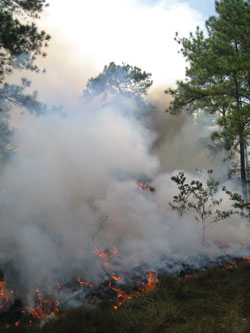Health guidelines for vegetation fire events
Fires in forests and other vegetation release polluting particulate matter, carbon monoxide and oxides of nitrogen, sulphur dioxide and organic compounds. Fine airborne particles (diameters smaller then 2.5 µm) have potentially detrimental health effects because they can penetrate deep into the human lungs. The World Health Organization (WHO) has identified a link between exposure to fine and ultrafine particles and hospital admissions, visits to emergency and outpatient departments and mortality due to respiratory and cardiovascular diseases.
In developing countries, vegetation fires increase the risk of acute respiratory infections, which are a major killer of young children. Severe forest fires arising from forest clearing in Southeast Asia in 1997–1998, for example, affected some 200 million people in Brunei Darussalam, Indonesia, Malaysia, the Philippines, Singapore and Thailand. Massive movement of populations fleeing the fires and smoke and the proliferation of emergency visits to hospitals added to the crisis. The number of cases of pneumonia increased from 1.5 to 25 times in Southeast Kalimantan, Indonesia, while in Malaysia the number of outpatient visits with respiratory diseases increased two- to threefold. Partly as a result of this severe fire occurrence, in 2002 the Association of Southeast Asian Nations (ASEAN) adopted the ASEAN Agreement on Transboundary Haze Pollution to control activities related to land and/or forest wildfires that may lead to transboundary haze pollution. Signatory countries agreed on activities for monitoring, assessment, prevention and preparedness, as well as subregional cooperation and coordination in managing the impact of such fires, which continue to occur almost annually.
The United Nations Environment Programme (UNEP), WHO, the World Meteorological Organization (WMO) and the Institute of Environmental Epidemiology, Singapore (IEE) have issued comprehensive guidelines for governments and responsible authorities on actions to be taken when their population is exposed to smoke from fires. Health guidelines for vegetation fire events (1999) gives information on vegetation fires at the global, regional and national levels obtained by remote-sensing, including information on the extent of the impact and the pollutants released. A related teachers’ guide compiles educational material for use in training courses. These publications are also available on CD-ROM.
The guidelines examine acute and chronic health effects of air pollution from forest and biomass fire. Mitigating measures that can be taken during acute smoke emergencies include:
- remaining indoors;
- reducing physical activity and refraining from smoking;
- using air cleaners;
- using gas masks and respirators;
- evacuating susceptible people to emergency shelters (e.g. schools or commercial buildings equipped with air conditioning and particle filtration systems).
The guidelines provide advice on effective public communications and mitigation measures, and guidance for assessing the health impacts of vegetation fires. They also describe measures on how to reduce the burden of mortality and preventable disability suffered particularly by the poor, and on the development and implementation of an early warning system for air pollution, based on monitoring and forecasting of ground and weather conditions.
| Smoke from forest fire causes significant human respiratory problems |
 |
P. Vuorinen |
Source: WHO. 2000. Vegetation fires.
Available at: www.who.int/mediacentre/factsheets/fs254/en/index.html |